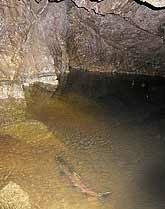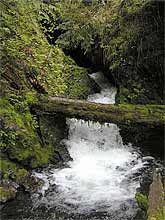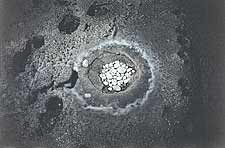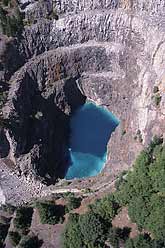Why is karst important? (Lesson 1, Part 2)
Karst is a unique, non-renewable resource that has many values.
On this page
- Biological values
- Hydrological values
- Mineralogical values
- Scientific values
- Cultural values
- Economic values
- Recreational values
Biological values
Forest productivity – Karst ecosystems are commonly more productive than similar forest sites on non-karst terrain. This increased productivity can be largely attributed to the well-drained soils and nutrient cycling associated with karst.
Plant and animal habitats – Karst ecosystems often support unusual or rare plant and animal species, both on the surface and underground. Here are some examples:
- Some ferns and mosses require a limestone substrate on which to grow and other fern species have adapted to growing in the cool, moist twilight conditions of cave entrances
- Elk and deer use cave entrances during summer for bedding down because the air from caves is cooler, and also during the winter when cave air is generally warmer than surrounding temperatures
- Trogloxenes utilize caves. For example, bats use caves for roosting and hibernation
- Troglobites are creatures that live permanently underground, beyond the daylight zone of caves, and cannot survive outside the cave environment. In B.C., some troglobites survived the last ice age in subsurface cavities and caves. The Stygobromus quatsinensis is a rare freshwater crustacean found in underground pools in caves on Vancouver Island
- Troglophiles, such as some species of salamanders, spiders and crickets, can utilize karst features for habitat
- Troglobites, troglophiles, and trogloxenes can be highly susceptible to even minor disturbances in their environment

Fisheries – It has been found that karst can contribute to high fish productivity because:
- The leaching of calcium carbonate from carbonate bedrock buffers acidic streams
- Cool karst groundwater can help stabilize stream temperatures
- The storage capacity of karst systems helps even out seasonal flows
- Karst streams are richer in nutrients and aquatic insect populations
- Karst stream systems can provide more protective sites for fish to rest, breed and avoid predators
Adult salmon in a cave - click for larger image
Hydrological values
Water quality and quantity issues play an important role in karst terrain:
- It can be difficult to determine the exact extent of subsurface drainage networks. For example, underground water systems usually operate independently from overlying surface drainage and sometimes cross topographic drainage divides
- Karst hydrological systems can move large quantities of water over great distances in a relatively short period of time. These rapid transit times and the limited ability of subsurface streams to cleanse and filter means that introduced harmful substances (for example, contaminants, sediments) have the potential to seriously impact sensitive karst environments, human water supplies, and important fish-rearing streams
- Variations in water quantity outside the range of natural conditions can alter groundwater recharge rates and impact ongoing karst processes
Below: Karst spring - click for larger image
Mineralogical values
Mineral deposits in karst terrain can be extensive, and come in a variety of forms.
- Recreation – Mineral deposits create formations that add to recreational values (for example, stalactites, stalagmites, moon milk, cave pearls, etc.)
- Mineral resources – Carbonate bedrocks have long been recognized for their mineral values
- Oil and gas – Karst areas can be favourable environments for oil and gas
Below: Cave pearls - click for larger image
Scientific values
Karst landscapes offer scientific opportunities:
- Geography/Geology – The study of cave morphology and secondary deposits, such as speleothems and sediments, provide a relatively undisturbed window into landform evolution, past environmental conditions and climate change
- Archaeology/Paleontology – Karst caves can be important sites for studying prehistoric living conditions because the natural environment (alkaline conditions, cool temperatures, the absence of light, difficult access) enhances preservation. Most of the known stone tools and skeletal remains of Homo neanderthalensis and early Homo sapiens are from limestone caves. The earliest known remains of humans in the Western hemisphere are found in US caves
11,000-year-old black bear bones in a Queen Charlotte Island cave - click for larger image
Cultural values
In the past, karst played a significant role in the lives of many aboriginal peoples:
- Caves were often used for shelter, burial sites, and ceremonial purposes and karst springs were viewed as having special properties
- The large trees produced on karst sites were important sources of construction material (dugouts, construction materials, totem poles etc.). Karst sites were also a source of shrubs and herbs used for food and medicines
- Many present-day aboriginal cultures continue to value karst for ancestral, heritage and cultural reasons
Below: Cave pictograph

Economic values
The primary economic benefits that karst landscapes provide to British Columbia are:
- Timber – High-value timber resources, particularly those found on Vancouver Island
- Agriculture – Karst areas are characteristically rich for agricultural purposes
- Minerals – The quarrying of limestone and dolomite is a major economic activity, providing raw materials and processed products for agriculture, glass and paint manufacturing, concrete production, pulp and paper production. Limestone, dolomite and marble are used for building and ornamental stone
- Recreation – Karst generates opportunities for employment and revenue from tourism (attractive surface karst features, underlying caves, high biodiversity)
Below: Limestone pit on Texada Island - click for larger image
Recreational values
Viewing and Caving – Each year, increasing numbers of people visit British Columbia’s provincial forests, parks, and recreation areas for self-guided or commercially guided karst and cave experiences. The extensive karst systems in the Rocky Mountains and on Vancouver Island are particularly popular viewing and cave exploration areas.
Recreational caver - click for larger image
Self check questions
Answer either True or False to check your understanding:
- Well-drained soils and efficient nutrient cycling contribute to the increased productivity of karst ecosystems
- There is no relationship between karst waters and fish productivity
- Subsurface karst water systems have superior cleansing and filtering mechanisms
- Surface karst and caves generate employment and revenue in B.C.'s tourism industry
Self check answers
- True
- False
- False
- True






